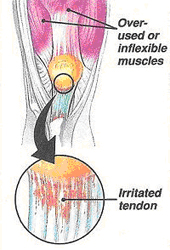Patella Tendonosis

Tendon injuries are now recognised as being degenerative not inflammatory. Tendon injuries are now referred to as tendonosis not tendonitis. The term “osis” meaning degeneration and “itis” meaning inflammation.
The Patella tendon connects the quadriceps muscles (at the front of the thigh) to the lower leg bone. The patella tendon runs from the bottom of the knee cap and inserts into a large bump at the top of the shin called the tibial tuberosity.
The patella tendon is thus loaded whenever the quads contract this is especially true when we jump, land or squat. Activities that involve a lot of jumping and landing have a large occurrence of patella tendonosis e.g. basketball.
Signs and Symptoms
Pain associated with patella tendonosis is at the location of the tendon. As described earlier the tendon runs from the bottom of the knee cap to the very top part of the shin at the front of the leg.
Pain usually occurs with activities that load the quads e.g. jumping, running however in severe cases pain may occur with relatively minor activities such as walking or even at rest.
Many patients will also describe stiffness and pain in the tendon first thing in the morning this stiffness resolves after a few hours and is related to fluid leaving the tendon at night.
Self Management
The best self management for tendon injuries is to reduce the stress going through the tendon at the first sign of symptoms.
The earlier the intervention the less the degeneration of the tendon and the better the outcome.
How treatment can help
Physiotherapy
- Will be able to assist in the diagnosis of the injury and differentiate it from other similarly presenting conditions e.g. fat pad impingement or patella mal-tracking.
- The aim of treatment is to unload the tendon this is achieved on many fronts. Improving quad muscle length by appropriate stretching or massage can reduce tendon stress
- Improving the strength and function of all leg muscles especially the quads, gluteals and calves is the single most important factor in resolution and prevention of reoccurrence. The more force that can be absorbed by the leg muscles the less force that goes through the tendon. The physio will guide you through a series of exercises looking at strength and power concentrating on areas that are deficient.
- Taping or tendon braces can improve symptoms
- Improving technique and biomechanics can also be very important to reduce tendon load and thus pain or reoccurrence.
Sports Physicians
Will be able to assist in diagnosis and if appropriate order investigations such as ultrasounds or MRI to assess the level of tendon damage.
In some cases if the symptoms are severe enough or tendon degeneration is severe doctors may inject a variety of different substances aimed at improving tendon repair. The substance injected will be depend on each case some examples are blood , cortisone or dry needling of the tendon.
Massage
Massage therapist can assist physiotherapists to reduce tightness in the muscles of the lower leg especially the quads and gluts.
Podiatry
In some cases foot orthosis may alter biomechanics unloading the tendon.
You may need Xrays and or an MRI scan to look at the architecture of your knee cap and the quality of your cartilage.
The earlier you seek treatment for this the quicker it can be cured. We aim to get you back running and pain free sooner.
02 9231 0102
Park House Level 3, 187 Macquarie St Sydney NSW 2000
Park House Level 3
187 Macquarie St
Sydney NSW 2000
187 Macquarie St
Sydney NSW 2000



